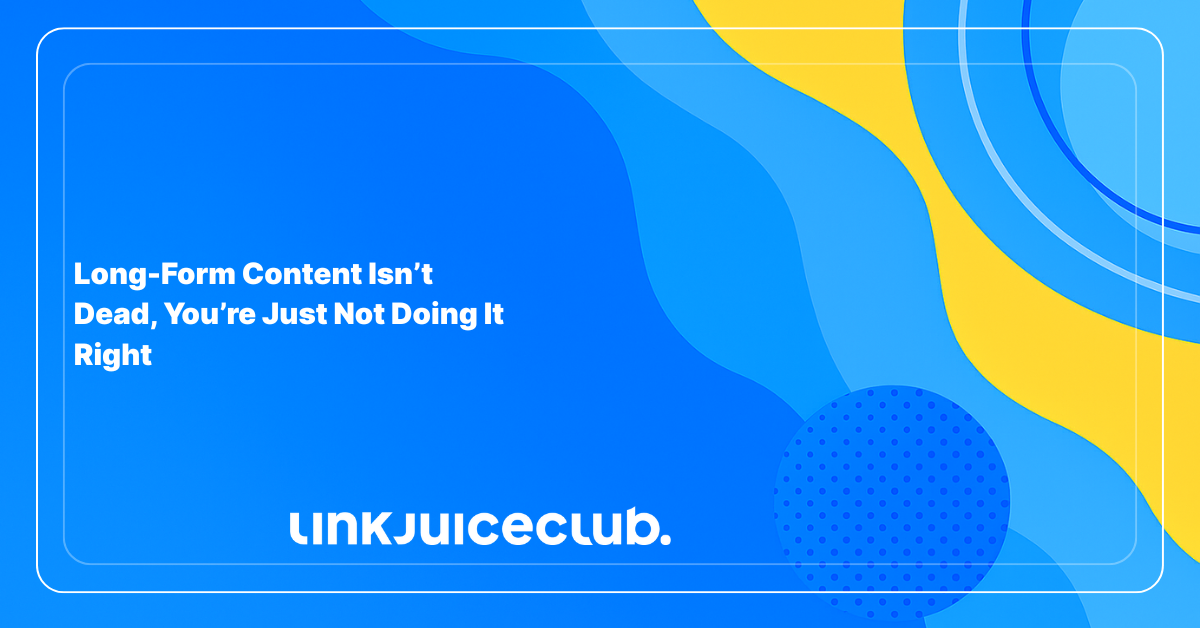
Long-Form Content Isn’t Dead, You’re Just Not Doing It Right
Once upon a time, marketers trembled at the thought of publishing anything over 1,000 words. They feared that no one would read it. Too long. Too dense. Too boring.
But here’s the truth: long-form content is very much alive and thriving, as long as you know how to write it. In fact, recent data shows that 37% of bloggers who write 2,000+ word pieces get the results others dream about.
When executed well, long-form content becomes your marketing Swiss Army knife. It ranks high, attracts backlinks like a magnet, feeds AI tools, and builds authority in your niche. And at Link Juice Club, that’s the kind of sticky SEO magic we live for!
So, What Counts as Long-Form Content Anyway?
Long-form content usually starts around 1,500 words and climbs from there. But the real magic is in the depth, structure, and usefulness.
Basically, if you’re going long, make it worth someone’s scroll. Answer questions they didn’t even know they had, and do it in a way that feels like a conversation, not a lecture.
Some types of content are just made to go long. Pillar pages are a great example. They’re like the main hub of your content, with everything else connecting back to them.

Then you’ve got step-by-step guides, detailed product explainers, in-depth whitepapers, and full resource pages that cover a topic from every angle. These aren’t quick reads; they’re the kind of pages people save, share, and come back to because they’re genuinely useful.
If someone finishes your content and still needs to Google more questions about the topic, it’s not complete yet. Great long-form content should leave the reader fully informed. It builds trust with your audience and shows search engines that you know what you’re talking about.
Short-Form vs. Long-Form
Short-form content is your sprinter: quick, flashy, and built for speed. Think about 300-word blog posts, punchy social captions, or those snappy newsletter intros you skim over coffee.
It’s great for getting attention, jumping on trends, or keeping your brand top-of-mind.
But if you’re trying to solve real problems, explain complex ideas, or build serious SEO muscle? Short-form often just doesn’t go the distance.
So, this is where long-form content comes to save the day. Long-form gives you room to explore a topic in depth, add real insight, and build trust. It supports multiple keywords naturally, offers better chances to rank, and keeps people on the page longer.
While short-form might be the bait, long-form is the entire fishing rod. It builds credibility, educates readers, and turns curious visitors into loyal fans.
Why Long-Form Wins the Search Intent Game
Now let’s talk about the secret sauce behind long-form content’s SEO power: search intent.
Search intent is basically the why behind a Google search:
- Is someone looking to learn something new? 💥
- Compare two tools? 💥
- Fix a problem they’re struggling with? 💥
- Make a purchase? 💥
Google’s job is to figure that out and it’s gotten frighteningly good at it. We’re talking next-level smart. It’s no longer impressed by keyword stuffing or robotic sentences.
It reads between the lines, evaluates content structure, and watches how users behave after they land on your page (scary, right?).
That’s where long-form content shines. It has the space to answer multiple related questions, provide helpful examples, guide the reader through a journey, and actually solve the problem that brought them to the search bar in the first place.
Long-Form Content Still Matters (And Here’s Why It Works So Well)
Data doesn’t lie; posts over 2,000 words consistently outperform shorter ones in rankings, backlinks, and time-on-page.
Why? Because when you write something valuable, people read it, save it, link to it, and (bonus) Google notices. Long-form pieces, when done right, are magnets for visibility.
Cover Multiple Angles of a Topic
Long-form content stands out because it gives you the space to explore a topic from every possible direction.
Instead of just skimming the surface, it lets you explore all the details.
Let’s say you need to write a guide on How to Start a Successful Remote Team. A short blog might mention tools like Slack and Zoom. But a well-structured long-form piece would unpack how to hire globally, set communication protocols, manage time zones, build remote culture, onboard new employees, track performance, and choose the right tech stack.
It doesn’t just answer the original question, it becomes the definitive resource. And when your page is that complete, users stay, share, and come back for more.
Drop in an FAQ and Watch Your Content Go Further
A strategically placed FAQ section at the end of your long-form content is SEO rocket fuel.
These quick-fire Q&As give your readers the answers they’re probably still wondering about, and they hand search engines even more context to chew on..
Let’s say you’re writing a monster guide on Launching a Paid Membership Community.
Your FAQ could cover things like: What’s the best platform to host it on? How do you price tiers without scaring off users? Should you open it all at once or roll it out gradually? These extras make your content feel complete and highly skimmable—perfect for readers in a hurry and algorithms that crave clarity.
Build a Structure That Deserves to Rank
Even the most brilliant piece of writing will flop if it reads like a wall of text.
That’s why a crystal-clear structure is non-negotiable. Think of your H2s and H3s like road signs. They help both your readers and Google understand where your content is headed and what’s worth stopping for.
This format keeps everything digestible and scan-friendly. It also sets your content up beautifully for passage indexing, where Google ranks specific sections of your article independently. Translation: one article, multiple chances to rank.
Long-Form Content Captures More Than Just One Keyword
What’s one thing we like about long-form content? It’s a keyword magnet. When you write in-depth, you’re not just targeting that juicy primary keyword; you’re also giving Google a buffet of long-tail phrases and semantically related searches to latch onto.
Instead of one doorway to your site, you now have ten, twenty, maybe even fifty.
Let’s say you’re creating a long-form guide called How to Start a Home Coffee Roasting Business.
If your article talks about equipment setup, sourcing beans, pricing strategies, legal requirements, and branding tips, Google will naturally connect it with other queries like:
- best green coffee suppliers, 💥
- how to price roasted coffee for retail, 💥
- coffee roasting licensing requirements in California. 💥
You didn’t write separate articles for each of those, but you still show up for them. That’s the power of comprehensive content!
Internal Linking and Authority Building Are Also Supported
Here’s where long-form content turns into a real SEO workhorse: internal linking. When your article spans a wide range of subtopics, it creates natural jumping-off points to other relevant pages on your site.
Let’s go back to our coffee roasting example. Maybe you’ve also got standalone posts on Top 5 Coffee Roasting Machines Under $500, Designing Coffee Labels That Sell, or Email Marketing Tips for Small Coffee Brands.
All of these can be linked from your main long-form guide. Now, Google sees you as a comprehensive source on the business of roasting coffee. That means better rankings, not just for your big guide, but for all the linked content too.
So, a well-crafted long-form article is the anchor of your internal content universe. Done right, it strengthens your entire domain’s relevance, improves crawlability, and keeps readers bouncing around your site instead of bouncing off it.
Long-Form Content = Digital Superglue for Your Audience
Let’s talk about bounce rate, the internet’s version of being ghosted. When someone lands on your page and disappears faster than a bad Tinder date, Google takes notes. It assumes your content didn’t vibe with the visitor, and that hurts your rankings.
But long-form content? It flips the script.
When your article is meaty, useful, and dripping with juicy stuff like embedded videos, visuals, and internal links, people stick around. They scroll deeper, click through related pages, maybe even watch that two-minute tutorial you snuck in halfway down. Every micro-action is a signal that screams ‘’This page delivers’’.
The MVP of B2B and Big-Decision Buyers
Long-form content isn’t just for lifestyle blogs and TikTok growth hacks. It shines brightest when the stakes are high, like in B2B and high-consideration industries where people don’t swipe their credit cards on a whim.
Think about someone trying to choose a cybersecurity solution for their company. They’re not impulse-buying based on a banner ad. They’re dissecting encryption protocols, comparing vendor lock-in policies, and probably Googling what is endpoint protection at 2 a.m. They need clarity, not clever slogans.
Now imagine they stumble across your 3,000-word masterpiece: The Ultimate Guide to Choosing a Cybersecurity Platform for Mid-Sized Teams. It’s all they need!
Want to take it even further? Design your content like it’s made to be quoted. Use standout lines, clean charts, and skimmable sections that can be screenshotted and dropped into a boardroom presentation without breaking a sweat.
Word Count Alone Won’t Save You: What Long-Form Content Really Needs to Rank
To earn higher rankings and keep your readers glued to the page, your content needs more than just length. So, here’s what separates high-quality long-form content from the pieces that simply aren’t good enough.

Cover the Topic Like You’ve Been Living It
If your content reads like you skimmed the Wikipedia entry five minutes before writing, you’re already out of the race.
Google’s goal is simple: serve up content that fully satisfies the reader’s intent.
That means going deep. Not just with keywords, but with related ideas, angles, questions, and context. You want your page to feel like a complete thought, not a first draft.
Don’t Just Answer the Question, Answer the Next One, Too
People rarely search in isolation. They come with one question, but a dozen more lurking behind it. Anticipating those follow-ups is the secret that turns a good article into a damn, this is everything I needed-experience.
Let’s say you’re writing a guide on building a webinar strategy. Sure, you’ll explain how to structure the webinar itself, but what about questions like When should I send reminder emails? or How do I repurpose the recording for social media? If you’re not answering those, someone else will.
Covering related questions keeps readers on the page, builds trust, and increases the chances they’ll return to you.
If It Looks Like Homework, No One’s Reading It
You could write the most brilliant, insightful content of the decade, but if it looks like a brick of uninterrupted text, people will simply not be interested.
Formatting is usability.
Make it ridiculously easy for people to find what they’re looking for. Use headings that signal value, keep paragraphs breezy, and break things up with visuals, charts, and clever section intros that make people want to read on.
Search Intent Is the Whole Game
Google’s watching every click, scroll, and back-button tap to judge whether your page actually solves the user’s problem… or just wastes their time.
So let’s get laser-focused: what was the person really looking for when they typed in that query?
Your job is to serve the right dish for the appetite.
- Serve a dense how-to article to someone who’s just browsing for pricing? They’re gone.💥
- Give a side-by-side feature breakdown to someone who’s still trying to figure out what a CRM even is? Also gone. 💥
Before you even start writing, do some SERP recon. Google your target keyword and actually study the top 3–5 results. What format wins? Are they listicles, guides, reviews, or giant PDFs disguised as blog posts? Spot the patterns and then figure out how you’re going to outshine them.
Speak the Searcher’s Language (Even If They Say It Differently)
No one Googles exactly like you do. Some people search Instagram analytics tools, while others type how to track Instagram engagement. Same need, different phrasing. And if your content doesn’t reflect that variety, you’re missing out on a whole chunk of your audience.
That’s why long-form content should be sprinkled with keyword variations that feel as natural as your morning coffee.
Plus, it makes your content feel way more human. Because guess what? Real people don’t speak in keywords! They speak in questions, problems, and outcomes.
Want Google’s Trust? Time to Show What You Know
If you’re publishing content that deals with real money, real health, or real consequences, Google’s not playing around. It wants proof that you, or whoever wrote the piece, actually knows what they’re talking about.
That’s where E-E-A-T (Experience, Expertise, Authoritativeness, and Trustworthiness) becomes central.
Start by putting a face behind the words. An author bio that highlights credentials, job titles, or actual experience tells both readers and search engines that this isn’t content pulled from thin air.
Of course, backing up your claims with data from credible sources never hurts. These are some ways to do this:
- Link to legit studies 💥
- Quote industry veterans 💥
- Let your readers fact-check you and come up impressed 💥
And if you’re not an expert? No shame in that, just borrow brilliance. Use your internal team for interviews or client anecdotes. A 15-minute convo with someone in product or customer success can unlock insights that make your content richer, smarter, and way more trustworthy.
Great Content Still Needs a Working Engine
You’ve written a killer long-form article. It’s sharp. It’s helpful. It’s everything a reader could want. But if your site moves slower than a sleepy sloth on a Monday morning, none of that brilliance is getting seen.
Technical optimization is the foundation! Page speed, mobile responsiveness, and crawlability are the silent gatekeepers that decide whether your content climbs the SERPs or gets buried under pages of mediocrity.
Simply put, your content has to load fast. Not kind of fast, but immediately. Because users won’t wait, and Google knows it.
Content Clusters: A Way to Make Google (and Your Readers) Feel at Home
Your long-form content is the big, beautiful main house, but if it’s sitting there all alone, with no paths or connections to other helpful pages, it feels… empty.
Google doesn’t love lonely pages. It prefers neighborhoods with clear roads, where everything’s connected and easy to explore. That’s what content clusters are all about.
Here’s how it works: start with one strong, detailed article that covers the whole topic from a high level. Then create a few smaller, focused articles that dive into specific parts of that big topic. Those are your supporting pieces.
Link them all together, so a reader can easily hop between them. Google sees this as a signal that you know your stuff and it boosts your authority.
One important thing: don’t use vague links like click here. Use anchor text that actually tells people where they’re going, such as:
- read more about onboarding strategies 💥
- check out our breakdown of welcome email timing. 💥
And when it comes to the length of those supporting pages? Aim for 800 to 1,200 words. That’s enough space to give solid advice without writing a novel. Each piece should cover one clear idea, so it adds real value and keeps the whole cluster working like a well-oiled machine.
Think Bigger, Rank Better: The Long-Form Mindset That Wins
We surely spoke a lot about long-form content! But one thing that you need to remember is: it’s all about strategy, structure, and serious value, the kind that makes readers stay, search engines smile, and competitors wonder what they’re doing wrong.
Let’s hit the highlights one more time:
- Depth beats fluff: Cover the full topic, not just the obvious parts. 💥
- Intent is everything: Align your content with what users actually want. 💥
- Formatting matters: Make it easy to read, scan, and enjoy. 💥
- E-E-A-T builds trust: Show experience, expertise, and proof you know your stuff. 💥
- Technical SEO isn’t optional: Fast, crawlable, and well-structured wins the race. 💥
- Content clusters rule: Build topic authority with connected pieces that play well together. 💥
And if that’s what you’re aiming for, there is one more thing you should know!
Link Juice Club is home to expert-level content creators who live and breathe long-form strategy. Whether you need cornerstone blog posts, high-authority guides, or in-depth SEO content, LJC is the place that gathers the best people from this industry.
Book a call with us today, and let’s build something that ranks. 📲





